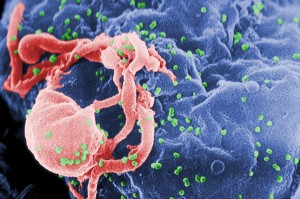WEDNESDAY, 23 JANUARY 2013
A T cell has one of two proteins on its surface that are recognised and exploited by HIV; CCR5 or CXCR4. Current drug therapies for HIV hinder the activities of these receptors; however the virus is able to readily mutate to counteract efforts to control it, and so a combination of drugs (highly active antiretroviral therapy (HAART)) is at present the best available treatment.The Stanford group led by Matthew Porteus MD hopes to imitate HAART using a genetic approach. Some individuals possess a CCR5 gene which is naturally resistant to HIV infection. Previous research carried out in Sangamo Biosciences has found that a particular protein called a zinc finger nuclease is able to bind to and break a normal CCR5 gene, causing it to mimic its resistant cousin. Porteus and his team have now taken this approach one step further. After using the nuclease to break the CCR5 DNA, they inserted genes known to confer HIV resistance into the cleavage site in a process known as ‘stacking’. The blockade of CCR5 and CXCR4 has not been previously achieved using this technique; however the introduction of three stacked genes in a laboratory setting conferred over a 1200 and 1700-fold resistance to infection in T cells carrying the CCR5 and CXCR4 receptors respectively.
There are still possible obstacles which need to be addressed before clinical trials can begin however. The team now need to test their methods on T cells from HIV patients to make sure that the nuclease doesn’t break the DNA in the wrong place and that the cells can survive the genetic alteration. If successful, the treatment would not cure HIV infection, but would help to combat the degeneration of the immune system associated with AIDS.
doi:10.1038/mt.2010.57
Written by Joanna-Marie Howes.

